Papers by Styliani Verykokou

Sensors
In the context of web augmented reality (AR), 3D rendering that maintains visual quality and fram... more In the context of web augmented reality (AR), 3D rendering that maintains visual quality and frame rate requirements remains a challenge. The lack of a dedicated and efficient 3D format often results in the degraded visual quality of the original data and compromises the user experience. This paper examines the integration of web-streamable view-dependent representations of large-sized and high-resolution 3D models in web AR applications. The developed cross-platform prototype exploits the batched multi-resolution structures of the Nexus.js library as a dedicated lightweight web AR format and tests it against common formats and compression techniques. Built with AR.js and Three.js open-source libraries, it allows the overlay of the multi-resolution models by interactively adjusting the position, rotation and scale parameters. The proposed method includes real-time view-dependent rendering, geometric instancing and 3D pose regression for two types of AR: natural feature tracking (NFT...

Journal of Clinical Medicine
The purpose of this article is to define and implement a methodology for the 3D design of customi... more The purpose of this article is to define and implement a methodology for the 3D design of customized patient-specific scaffolds (bone grafts) for the regeneration of periodontal tissues. The prerequisite of the proposed workflow is the three-dimensional (3D) structure of the periodontal defect, i.e., the 3D model of the hard tissues (alveolar bone and teeth) around the periodontal damage, which is proposed to be generated via a segmentation and 3D editing methodology using cone beam computed tomography (CBCT) data. Two types of methodologies for 3D periodontal scaffold (graft) design are described: (i) The methodology of designing periodontal defect customized block grafts and (ii) the methodology of designing extraction socket preservation customized grafts. The application of the proposed methodology for the generation of a 3D model of the hard tissues around periodontal defects of a patient using a CBCT scan and the 3D design of the two aforementioned types of scaffolds for perso...
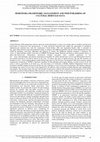
ISPRS Annals of the Photogrammetry, Remote Sensing and Spatial Information Sciences
Cultural Heritage (CH) management software represents virtual information in various ways aiming ... more Cultural Heritage (CH) management software represents virtual information in various ways aiming either at usability and long-term preservation or interactivity and immersiveness. A single web-based framework that couples the organization of geospatial, multimedia and relational data with 4D visualization, Virtual Reality (VR) and Augmented Reality (AR) is presented in this paper (https://meteora.topo.auth.gr/5dmeteora.php). It comprises the 5dMeteora platform and the Content Management System (CMS) for uploading, processing, publishing and updating its content. The 5dMeteora platform integrates a responsive 3D viewer of high-resolution models in the basis of 3DHOP (3D Heritage Online Platform) and Nexus.js multi-resolution library. It offers data retrieval and interpretation mechanisms through navigation tools, clickable geometries in the 3D scene, named hotspots, and semantic organization of metadata. Its content and interactive services are differentiated, based on the scientific specialty or the field of interest of the users. To achieve the sense of spatial presence, VR and AR viewports are designed to give a clearer understanding of spatial bounds and context of 3D CH assets. The proposed CMS allows dynamic content management, automation of 3DHOP's operations regarding 3D data uploading and hotspots defining, real-time preview of the 3D scene as well as extensibility at all levels (e.g., new data types). It is built upon a MySQL Database Management System and developed with PHP scripting, backend JavaScript and Ajax controllers as well as front-end web languages. The database maintains and manages the entities of every type of data supported by the platform, while encryption methods guarantee data confidentiality and integrity. The presented work is the first valid attempt of open-source software that automates the dissemination of 3D and 2D content for customized eXtented Reality (XR) experiences and reaches multiple levels of interactivity for different users (experts, non-experts). It can meet the needs of domain experts that own or manage multimodal heritage data.
Sensors
Advances in the scientific fields of photogrammetry and computer vision have led to the developme... more Advances in the scientific fields of photogrammetry and computer vision have led to the development of automated multi-image methods that solve the problem of 3D reconstruction. Simultaneously, 3D scanners have become a common source of data acquisition for 3D modeling of real objects/scenes/human bodies. This article presents a comprehensive overview of different 3D modeling technologies that may be used to generate 3D reconstructions of outer or inner surfaces of different kinds of targets. In this context, it covers the topics of 3D modeling using images via different methods, it provides a detailed classification of 3D scanners by additionally presenting the basic operating principles of each type of scanner, and it discusses the problem of generating 3D models from scans. Finally, it outlines some applications of 3D modeling, beyond well-established topographic ones.

Although vertical aerial images have played the leading role in photogrammetric applications for ... more Although vertical aerial images have played the leading role in photogrammetric applications for more than a century, in recent years oblique aerial images have gained popularity, mainly because of certain fundamental advantages they provide compared to nadir views, in combination with the progress made in photogrammetric and computer vision algorithms that enable their automatic processing. The main subject of this dissertation is the metric exploitation of datasets containing oblique aerial images, with emphasis on the establishment of automatic georeferencing algorithms, both in terms of exterior orientation estimation and in terms of image-to-ground 2D transformation, i.e., polynomial/projective transformation that approximates the relationship between each image and the ground reference system. Furthermore, it investigates how the automatic extraction of elements describing the geometry of the scene depicted in oblique aerial images contributes in their metric exploitation, foc...
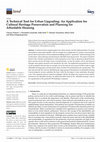
Land
A technical tool to support projects for urban reforms and the implementation of current land pol... more A technical tool to support projects for urban reforms and the implementation of current land policies is presented together with an example for its application in a project concerning the preservation of privately-owned residential buildings listed as “protected” cultural heritage (CH) constructions, urban planning and planning for affordable housing provision. The projects should be based on the voluntary participation of current property owners and an agreement signed between them and the private developer (team of professionals), so that the project will be self-financed through value capture measures to be decided by the state. The application presented here is based on the assumption that the state, by example, has set the rules for an increase in FAR in order to apply affordable housing policy and the preservation of listed CH residential private constructions. The state also provides the rules for identifying the target group of beneficiaries for affordable housing. Current ...

Η επαυξημένη πραγματικότητα είναι μία ραγδαίως εξελισσόμενη τεχνολογία που εμπλουτίζει την πραγμα... more Η επαυξημένη πραγματικότητα είναι μία ραγδαίως εξελισσόμενη τεχνολογία που εμπλουτίζει την πραγματικότητα με πληροφορίες που παράγονται από έναν υπολογιστή. Μολονότι η έννοια αυτή συναντάται για πρώτη φορά τη δεκαετία του 1960, τα τελευταία χρόνια έχει αρχίσει να παρουσιάζει πρακτικές εφαρμογές σε διάφορους τομείς και σήμερα κεντρίζει το ενδιαφέρον πολλών ερευνητών, επιστημόνων αλλά και εταιριών. Σκοπός της συγκεκριμένης διπλωματικής εργασίας είναι η ανάπτυξη εφαρμογών επαυξημένης πραγματικότητας βάσει επίπεδου προτύπου, εσωτερικού και εξωτερικού χώρου, με τη χρήση αλγορίθμων και μεθόδων της φωτογραμμετρίας και της όρασης υπολογιστών. Οι εφαρμογές αυτές αναπτύχθηκαν στη γλώσσα προγραμματισμού C++, με χρήση της βιβλιοθήκης OpenCV, της διεπαφής προγραμματισμού εφαρμογών OpenGL και της βιβλιοθήκης GLM: An Alias Wavefront OBJ file Library και είναι εφαρμογές κονσόλας Win32, που εκτελούνται σε ηλεκτρονικούς υπολογιστές με λειτουργικό σύστημα Microsoft Windows. Στην παρούσα εργασία, γίνετ...

The mission of digital Cultural Heritage (CH) repositories goes beyond engagement and disseminati... more The mission of digital Cultural Heritage (CH) repositories goes beyond engagement and dissemination; their research data should be approached and correlated spatially and semantically in the service of conservation and accessibility. Therefore, a flexible system is needed to expand, reuse and repurpose their content, addressing online collaboration, real time progress and ease of use. Towards this direction, the “METEORA” web-based platform is a novel and holistic approach to the organization, management and visualization of the 3D and 2D documentation products of CH sites. It integrates a multi-scale 3D viewer based on the 3DHOP framework, personalized information access and interactive tools for data retrieval and presentation. Emphasis is given in the development of a mid-level interface for creating, updating and maintaining 3DHOP’s functionalities and customizing information based on the user’s scientific specialty and field of interest. The proposed admin control panel updates...
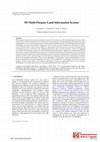
The complexity of modern urban environments has led to the introduction of 3D Land Information Sy... more The complexity of modern urban environments has led to the introduction of 3D Land Information Systems (LISs), which tend to replace traditional 2D LIS architectures for the purposes of urban planning and regeneration, land administration, real estate management and civil development. Both the need for 3D visualization of the geometry of buildings in various time instances through the years and the need for acquisition of 3D models in various levels of detail (LoDs), which not only fulfill the requirements of the various users but also they speed up the visualization process, are obvious. Thus, additional dimensions, that is, for time and scale, need to be supported by a modern LIS. This paper introduces a 5D modelling pipeline that may be adopted by a multi-purpose LIS for the selective creation of 3D models of an urban area in various time instances and at various LoDs, enriched with cadastral and other spatial data. The methodology is based on automatic change detection algorithm...
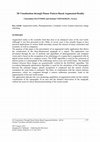
Augmented reality is the scientific field that aims at an enhanced sense of the real world. Altho... more Augmented reality is the scientific field that aims at an enhanced sense of the real world. Although it was first presented in the 1960s, in recent years it has actually begun to have practical applications in various fields and today arouses the interest of many researchers and scientists, as well as companies. The purpose of this paper is the presentation of an augmented reality application that allows the visualization of the three-dimensional anaglyph of a region. The application was developed through the use of methods and algorithms of photogrammetry and computer vision and is based on the recognition of an orthoimage of a region that is augmented with its digital terrain model on a computer screen. The SURF algorithm is used for the extraction of interest points in a photograph of the orthoimage and in every real world frame. The matched features between these images are geometrically verified by the RANSAC algorithm. The Levenberg-Marquardt optimization algorithm is used for the calculation of the homography between the matched images, pattern recognition is conducted and the camera exterior orientation for each frame is estimated. The latter, in combination with the camera intrinsic parameters, which are computed through a camera calibration procedure, leads to the augmentation of the real world scenes. The application indicates the very promising capabilities of augmented reality for the realistic visualization of the topography of an area and the detailed observation of the anaglyph, without the need of a three-dimensional printing of the terrain model.
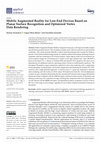
Applied Sciences, 2021
Mobile Augmented Reality (MAR) is designed to keep pace with high-end mobile computing and their ... more Mobile Augmented Reality (MAR) is designed to keep pace with high-end mobile computing and their powerful sensors. This evolution excludes users with low-end devices and network constraints. This article presents ModAR, a hybrid Android prototype that expands the MAR experience to the aforementioned target group. It combines feature-based image matching and pose estimation with fast rendering of 3D textured models. Planar objects of the real environment are used as pattern images for overlaying users’ meshes or the app’s default ones. Since ModAR is based on the OpenCV C++ library at Android NDK and OpenGL ES 2.0 graphics API, there are no dependencies on additional software, operating system version or model-specific hardware. The developed 3D graphics engine implements optimized vertex-data rendering with a combination of data grouping, synchronization, sub-texture compression and instancing for limited CPU/GPU resources and a single-threaded approach. It achieves up to 3× speed-u...

Η ραγδαία πρόοδος που σημειώθηκε τα τελευταία χρόνια στην ψηφιακή τεχνολογία δημιούργησε τις προϋ... more Η ραγδαία πρόοδος που σημειώθηκε τα τελευταία χρόνια στην ψηφιακή τεχνολογία δημιούργησε τις προϋποθέσεις για την εντυπωσιακή εξέλιξη των επιστημονικών περιοχών της φωτογραμμετρίας και της όρασης υπολογιστών. Το γνωστικό τους πεδίο διευρύνεται συνεχώς και οι μεθοδολογίες τους αναμορφώνονται και εξελίσσονται ώστε να ικανοποιούν τις απαιτήσεις των σύγχρονων εφαρμογών. Έτσι, ενώ στο παρελθόν η διαδικασία εξαγωγής μετρητικής πληροφορίας από αεροφωτογραφίες στηριζόταν σχεδόν αποκλειστικά σε κατακόρυφες εναέριες λήψεις, τα τελευταία χρόνια οι πλάγιες εναέριες εικόνες ήλθαν στο προσκήνιο και αποτελούν όχι μόνο ένα συμπληρωματικό σύνολο δεδομένων για τις παραδοσιακές κατακόρυφες εικόνες, αλλά και τη βασική πηγή πληροφοριών για διάφορες εφαρμογές. Προς αυτή την κατεύθυνση, έχει διεξαχθεί σημαντική έρευνα για εφαρμογές οι οποίες αξιοποιούν σύνολα πλάγιων εναέριων εικόνων κυρίως από μετρητικές φωτομηχανές ή συστήματα πολλαπλών φωτομηχανών, υπό την προϋπόθεση ύπαρξης δεδομένων γεωαναφοράς από α...
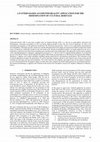
ISPRS Annals of the Photogrammetry, Remote Sensing and Spatial Information Sciences, 2021
Augmented Reality (AR) is more than an added value for Cultural Heritage (CH); it is vital for it... more Augmented Reality (AR) is more than an added value for Cultural Heritage (CH); it is vital for its sustainability, promotion and dissemination, increasing accessibility in CH even during difficult periods of time, like the Covid-19 pandemic. In order to be meaningful and engaging, an AR application should have the following characteristics: easiness of use, high-quality representations and compatibility. This paper presents a marker-less mobile AR application for the display and inspection of high-resolution 3D cultural assets, overlayed on a particular location in the real-world scene. Instead of predefined markers, an image captured by the user is exploited as a pattern for real-time feature matching, pose estimation and scene augmentation. Our approach is based on pure computer vision and photogrammetric techniques, implemented using native C++ and Java code for Android mobile platforms. It is built with the use of the OpenCV library and the OpenGL ES graphics API without any dependencies of AR Software Development Kits (SDKs). Therefore, it supports cross-vendor portability regarding mobile model devices and hardware specifications. The evaluation of the developed application examines the performance of various matching techniques and the overall responsiveness of processing and 3D rendering on mid-range and low-end smartphones. The results showcase the reliability and responsiveness of the pattern recognition as well as the potential of the 3D graphics engine to render and overlay complex 3D models balancing between visual quality and time. The proposed methodology is applied to the Ciborium of the church of St. Charalabos, located at St. Stephen's Monastery in Meteora, Greece.
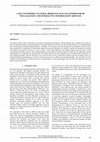
ISPRS - International Archives of the Photogrammetry, Remote Sensing and Spatial Information Sciences, 2020
The already arduous task of collecting, processing and managing heterogeneous cultural heritage d... more The already arduous task of collecting, processing and managing heterogeneous cultural heritage data is getting more intense in terms of indexing, interaction and dissemination. This paper presents the creation of a 4D web-based platform as a centralized data hub, moving beyond advanced photogrammetric techniques for 3D capture and multi-dimensional documentation. Precise metric data, generated by a combination of image-based, range and surveying techniques, are spatially, logically and temporally correlated with cultural and historical resources, in order to form a critical knowledge base for multiple purposes and user types. Unlike conventional information systems, the presented platform, which adopts a relational database model, has the following front-end functionalities: (i) visualization of high-resolution 3D models based on distance dependent Level of Detail (LoD) techniques; (ii) web Augmented Reality; and (iii) interactive access and retrieval services. Information deduced from the developed services is tailored to different target audiences: scientific community, private sector, public sector and general public. The case study site is the UNESCO world heritage site of Meteora, Greece, and particularly, two inaccessible huge rocks, the rock of St. Modestos, known as Modi, and the Alyssos rock.

ISPRS Annals of the Photogrammetry, Remote Sensing and Spatial Information Sciences, 2018
The purpose of this paper is the presentation of a novel algorithm for automatic estimation of th... more The purpose of this paper is the presentation of a novel algorithm for automatic estimation of the exterior orientation parameters of image datasets, which can be applied in the case that the scene depicted in the images has a planar surface (e.g., roof of a building). The algorithm requires the measurement of four coplanar ground control points (GCPs) in only one image. It uses a template matching method combined with a homography-based technique for transfer of the GCPs in another image, along with an incremental photogrammetry-based Structure from Motion (SfM) workflow, coupled with robust iterative bundle adjustment methods that reject any remaining outliers, which have passed through the checks and geometric constraints imposed during the image matching procedure. Its main steps consist of (i) determination of overlapping images without the need for GPS/INS data; (ii) image matching and feature tracking; (iii) estimation of the exterior orientation parameters of a starting image pair; and (iv) photogrammetry-based SfM combined with iterative bundle adjustment methods. A developed software solution implementing the proposed algorithm was tested using a set of UAV oblique images. Several tests were performed for the assessment of the errors and comparisons with well-established commercial software were made, in terms of automation and correctness of the computed exterior orientation parameters. The results show that the estimated orientation parameters via the proposed solution have comparable accuracy with those ones computed through the commercial software using the highest possible accuracy settings; in addition, double manual work was required by the commercial software compared to the proposed solution.
International Journal of Remote Sensing, 2018

Multimedia Tools and Applications, 2017
Natural and man-made disasters that may take place due to a catastrophic incident (e.g., earthqua... more Natural and man-made disasters that may take place due to a catastrophic incident (e.g., earthquake, explosion, terrorist attack) often result in trapped humans under rubble piles. In such emergency response situations, Urban Search and Rescue (USaR) teams have to make quick decisions under stress in order to determine the location of possible trapped victims. Fast 3D modelling of fully or partially collapsed buildings using images from Unmanned Aerial Vehicles (UAVs) can considerably help USaR efforts, thus improving disaster response and increasing survival rates. The a-priori establishment of a proper workflow for fast and reliable image-based 3D modelling and the a priori determination of the parameters that have to be set in each step of the photogrammetric pipeline are critical aspects that ensure the readiness in an emergency response situation. This paper evaluates powerful commercial and open-source software solutions for the 3D reconstruction of disaster scenes for rapid response situations. The software packages are tested using UAV datasets of a real earthquake scene. A thorough analysis on the parameters Multimed Tools Appl

Lecture Notes in Computer Science, 2016
The creation of 3D models of Cultural Heritage (CH) sites that have undergone a severe disaster d... more The creation of 3D models of Cultural Heritage (CH) sites that have undergone a severe disaster due to a catastrophic incident (e.g., earthquake, explosion, terrorist attack) is of great importance for several use cases. Different actors, like Urban Search and Rescue crews, structural, civil and surveying engineers, people in charge of restoration plans, archaeologists, architects, reporters, television presenters and computer engineers, may exploit the 3D information in a different way. Hence, each of them needs models of different scales/levels of detail and under different time constraints. In this paper the need for multi-scale 3D models of severely damaged or collapsed CH sites is addressed and various use cases are discussed. Also, image-based workflows are established for creating multi-scale 3D products via UAV images of a damaged church due to an earthquake. The models of different scales require very different amounts of time for their generation and may be used for search and rescue, damage assessment, geometric documentation, planning of repair works and simple visualization.
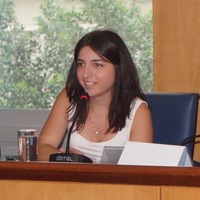
Uploads
Papers by Styliani Verykokou